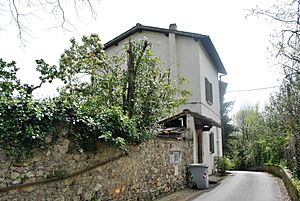Clementina Anstruther-Thomson facts for kids
Quick facts for kids
Clementina Anstruther-Thomson
|
|
|---|---|

Portrait of Clementina Anstruther-Thomson by John Singer Sargent (1889)
|
|
| Born | 1857 |
| Died | 1921 (aged 63–64) |
| Nationality | Scottish |
| Occupation | Author |
| Known for | Experimental aesthetics |
Clementina "Kit" Caroline Anstruther-Thomson (1857–1921) was a Scottish author and art expert. She was famous for writing and giving talks about experimental aesthetics. This means she studied how art affects people's bodies and feelings. She lived during the Victorian era. Her work with another writer, Vernon Lee, helped Lee become more interested in how art affects our minds.
Early Life
Clementina Anstruther-Thomson was born in 1857. She came from an important Scottish family. Her father was John Anstruther-Thomson. Her mother was Caroline Maria Agnes Robina Gray. Her grandfather was also named John Anstruther-Thomson. He was an officer in the British Territorial Army.
Exploring Art and Feelings
The aesthetic movement started in the United Kingdom in the 1860s. This was during the Victorian period. Writers in this movement focused on how art made people feel. Clementina Anstruther-Thomson was especially interested in how art affected the body.
She once gave a talk called "What Patterns Do to Us." In this talk, she asked the audience to touch a patterned vase. She wanted them to "feel its effect on their bodies." This showed her belief that art could be experienced physically.
Before they met, Vernon Lee already knew about Anstruther-Thomson's work. People who knew Anstruther-Thomson often said she looked like an ancient Greek sculpture. Vernon Lee often wrote about how much she admired Anstruther-Thomson's physical appearance. When they looked at art together, Lee's experience was often linked to her admiration for Anstruther-Thomson's body, which she saw as a perfect artistic form.
Working with Vernon Lee

Clementina Anstruther-Thomson met Vernon Lee in 1888. For the next twelve years, they lived together as close companions and co-authors. They lived in Italy for a while. They also traveled often between Italy and Britain.
During their time together, they did many experiments about art and feelings. They wrote down what they found. In the 1890s, Anstruther-Thomson and Lee visited many museums. They traveled all over Europe. They carefully watched how their bodies reacted to different artworks. They wrote down these observations.
In 1897, they published their findings in an article called "Beauty and Ugliness." This article looked at how our bodies react to art. Their research was based on the James–Lange theory. This theory says that our bodies respond to things first, and then we feel emotions. However, many people did not take their findings seriously. Their close relationship was criticized by some friends.
Later Life
After "Beauty and Ugliness" was published, Clementina Anstruther-Thomson and Vernon Lee slowly grew apart. They ended their close living arrangement in 1898. However, they remained good friends. Later, Anstruther-Thomson became close with Fflorens Roch. Fflorens Roch was a Welsh author. She was also a leader for the Girl Guides in Wales. They were often together.
Later in her life, Anstruther-Thomson worked a lot with the Girl Guides Association. Many of the leaders in the Girl Guides were single women. For some, the Girl Guides offered a safe and welcoming place. Anstruther-Thomson helped organize and train leaders. She was a County Commissioner until she passed away. She was buried with her family in Kilconquhar Parish Churchyard, Kilconquhar.
After her death, Vernon Lee collected Anstruther-Thomson's writings about art. They were published in a book called Art and Man in 1924. Lee also wrote an introduction for the book. It described their shared experiences with art.
Her Beliefs
Clementina Anstruther-Thomson was a humanist. This means she believed in human values and reason. She also supported the British Ethical movement. She was a member of the West London Ethical Society. This group later became Humanists UK. They remembered her as one of their "heroines of freethought."

